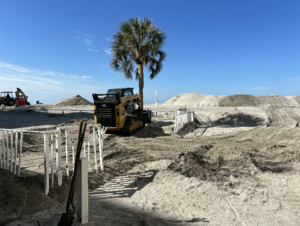
A Gulf-front property in Venice being cleared following Hurricane Milton, October 17, 2024
The impacts of severe hurricanes are often wide-reaching and multifaceted, and Helene and Milton’s paths of devastation in Florida will be no exception. With so many residents suffering flood damage and without flood insurance to help repair their homes, what will they do? Do they have or will they be able to find the money – beyond the average FEMA assistance of about $5,000 – to rebuild and remain in their home? Or will they have to sell their house “as is” and find somewhere else to live?
A recent story by the Associated Press says history suggests those residents will remain in Florida, and if they move, it will be just a few miles to inland communities. Many will rebuild even in the face of our stronger hurricanes of late.
Many factors are at play in rebuilding, including the property’s specific location, the speed of insurance reimbursement, and the supply of construction labor to rebuild. The AP references a 2020 study on the impact of hurricanes on Florida’s housing markets from 2000 to 2016. It found older people with more financial resources stay and rebuild. Those who do sell their damaged homes usually find ready buyers willing to buy it for the value of the land and then build new homes under updated building codes that will better withstand the next storm. The study found that home prices in a market struck by a hurricane, three years later, are 5% higher on average than elsewhere in the state, but that new buyers for those homes are more affluent and able to afford the increase.
Thanks to progressively stricter building codes after 1992’s devastating Hurricane Andrew, these newer, more expensive homes are better equipped to withstand hurricanes, so the storms claim fewer lives and cost less in the long-run. Mitigating storm damage in both new and existing homes is possible and important: it’s why we devoted our last LMA Newsletter to fortified homes. It’s vital to our residents and the long-term health of the communities in which they live. And while some residents of barrier island communities have decided to move to the mainland to avoid future storm damage, by and large, Floridians just keep building in high-risk areas, per last week’s Wall Street Journal, constructing 77,000 new properties in these red zones since 2019.
People like the beach and want to live along the water, as evidenced by the ever-booming real estate industry in Florida. Insurance companies price homeowners and flood insurance policies to risk – so there’s indeed a higher price to pay living on the coast going into the calculation. While the hurricanes keep coming, Floridians seem more than willing to face the storm time and time again, and hopefully, in the right hands, our communities can come out the other side stronger and safer.
See you on the trail,
Lisa

